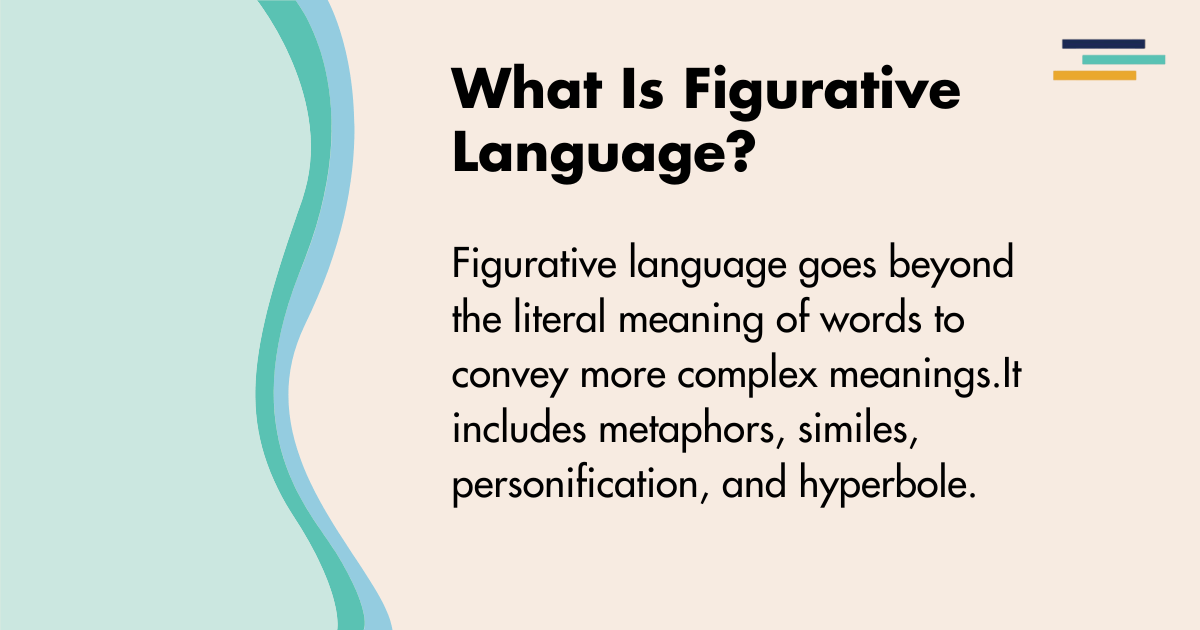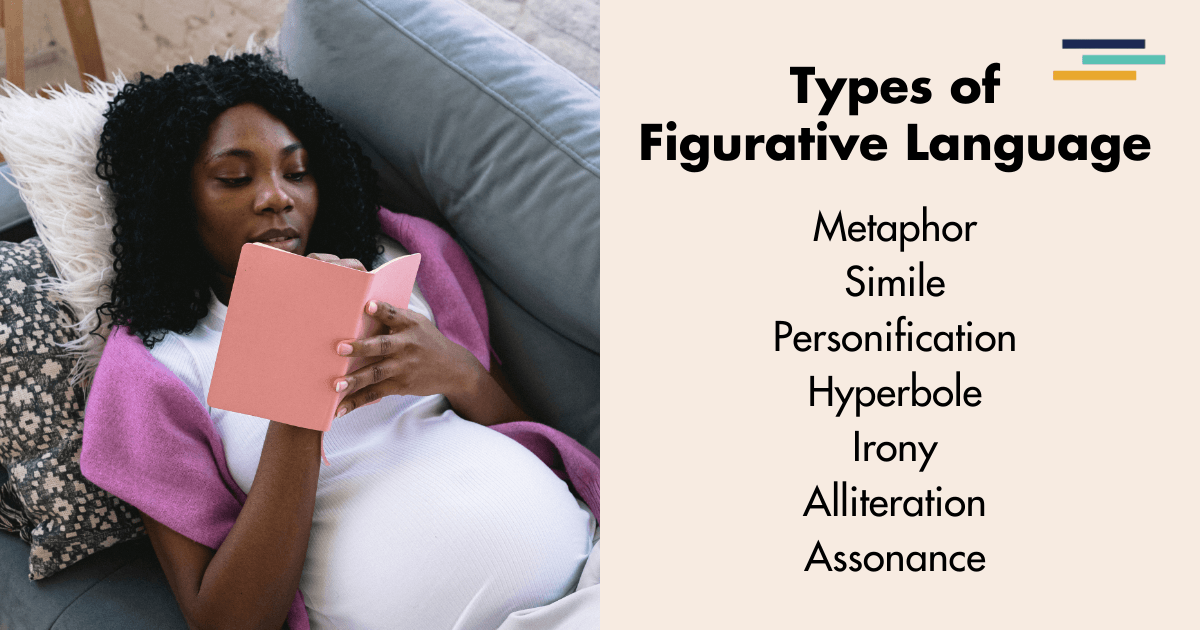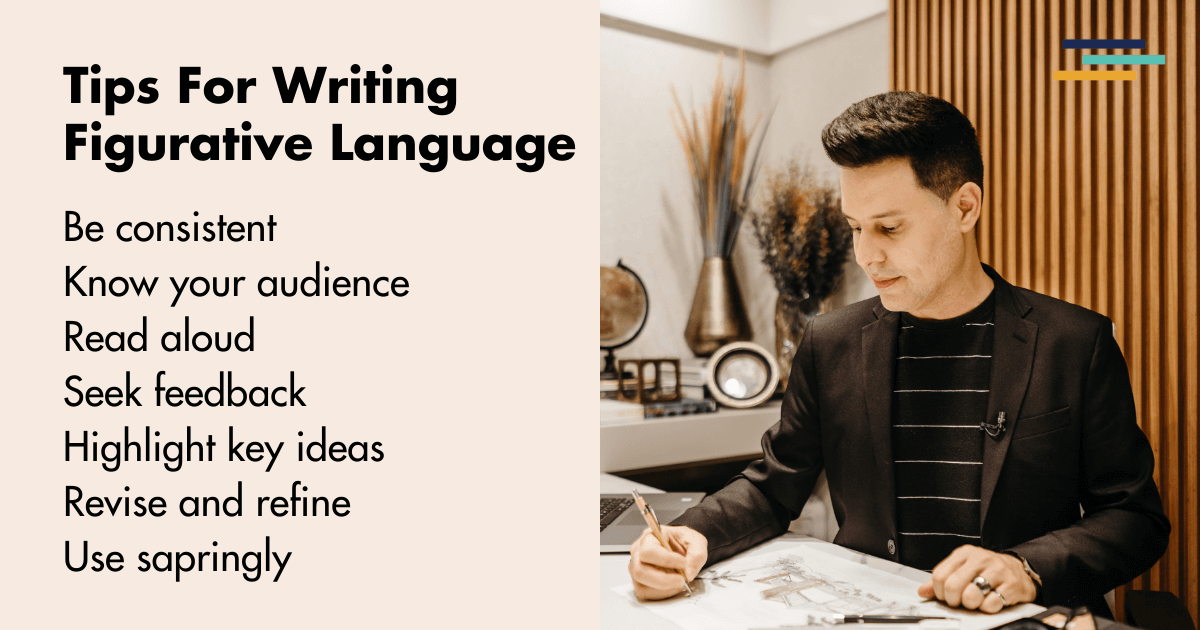
Figurative language can be one of those really confusing literary devices that has you scratching your head, like, huh? What’s going on here?
But it doesn’t have to be.
Figurative language is a fundamental element of literature that enhances the beauty, depth, and meaning of your writing. It enables you to express complex ideas and emotions in imaginative and relatable ways, transcending the literal interpretation of words.
This article delves into the various types of figurative language, their definitions, meanings, and examples, and offers tips on how to incorporate them into your writing.
Are you ready to supercharge your writing with figurative language?
Then let’s dive in.
What Is Figurative Language?
Figurative Language Definition Literature
Figurative language refers to expressions that go beyond the literal meaning of words to convey more complex or nuanced meanings.
It encompasses a variety of figures of speech, such as metaphors, similes, personification, and hyperbole.
You can use these devices to create vivid imagery, express emotions, and articulate abstract ideas in a way that resonates with readers on a deeper level.
Figurative Language Meaning
The meaning of figurative language extends beyond the direct interpretation of words. It involves an imaginative and interpretative process to uncover the underlying message or significance of the words.
Figurative language enhances the reader’s engagement by making the text more vibrant and evocative, allowing for a more profound connection with the material.

What Are the 10 Types of Figurative Language?
Here’s a quick summary of some common types of figurative language.
- Metaphor: A direct comparison between two unlike things without using “like” or “as”
- Simile: A comparison between two unlike things using “like” or “as”
- Personification: Attributing human characteristics to non-human entities
- Hyperbole: An exaggerated statement not meant to be taken literally
- Onomatopoeia: A word that imitates the sound it represents
- Oxymoron: A figure of speech in which contradictory terms appear together
- Irony: A contrast between expectation and reality
- Alliteration: The repetition of the initial consonant sounds in a series of words
- Assonance: The repetition of vowel sounds within nearby words
- Synecdoche: A figure of speech in which a part is used to represent the whole or vice versa

Examples of Figurative Language Types
Metaphor
A metaphor directly compares two unlike things, suggesting they are alike.
- “Time is a thief.” This metaphor suggests that time steals moments from our lives.
- “Her heart is a cold iron.” This suggests an emotional coldness or unyielding nature.
- “Books are windows to the world.” This suggests that books offer expansive views and understanding of the world.
- “The world’s a stage.” This metaphor implies that life is like a play where everyone has a role to enact.
- “His words were a dagger to her heart.” This suggests that his words were extremely hurtful.
Simile
A simile compares two unlike things using the words “like” or “as.”
- “Her smile was as bright as the sun.” This simile compares the brightness of her smile to the sun.
- “He fought like a lion.” This suggests bravery and ferocity.
- “She is as busy as a bee.” This suggests that she is very industrious and hardworking.
- “Her voice was like nails on a chalkboard.” This simile suggests that her voice was very unpleasant to hear.
- “He was as cool as a cucumber under pressure.” This suggests that he remained calm and collected.
Personification
Personification attributes human qualities to non-human entities.
- “The wind whispered through the trees.” This personification gives the wind the human ability to whisper.
- “The stars danced in the sky.” This suggests movement and liveliness of the stars.
- “The car groaned as it climbed the hill.” This gives the car human-like qualities of making sounds of effort.
- “The leaves waved in the wind.” This suggests that the leaves moved in a human-like way.
- “The alarm clock yells at me every morning.” This suggests that the alarm clock makes a loud and insistent noise, like yelling.
Hyperbole
Hyperbole involves exaggerated statements that are not meant to be taken literally.
- “I’m so hungry I could eat a horse.” This hyperbole exaggerates the speaker’s level of hunger.
- “I’ve told you a million times.” This suggests frequent repetition.
- “He runs faster than the wind.” This exaggerates the person’s speed.
- “This bag weighs a ton.” This hyperbole suggests that the bag is very heavy.
- “It took forever to get here.” This exaggerates the amount of time it took to arrive.
Onomatopoeia
Onomatopoeia refers to words that imitate natural sounds.
- “The bees buzzed in the garden.” The word “buzzed” imitates the sound that bees make.
- “The leaves rustled in the wind.” “Rustled” imitates the sound of leaves moving.
- “The clock ticked loudly in the quiet room.” “Ticked” mimics the sound a clock makes.
- “The bacon sizzled in the pan.” “Sizzled” imitates the sound of cooking bacon.
- “The door creaked open.” “Creaked” mimics the sound of an old door opening.
Oxymoron
An oxymoron is a figure of speech where contradictory terms appear together.
- “Bittersweet.” This oxymoron combines the contradictory terms “bitter” and “sweet.”
- “Deafening silence.” This suggests a silence so profound it feels overwhelmingly loud.
- “Living dead.” This combines the contradictory concepts of life and death.
- “Jumbo shrimp.” This oxymoron combines the contradictory terms “jumbo” and “shrimp.”
- “Act natural.” This combines the contradictory instructions to “act” and be “natural.”
Irony
Irony involves a contrast between what you expect and what actually occurs.
- “A fire station burns down.” This situation is ironic because a fire station prevents fires.
- “A pilot with a fear of heights.” This is ironic because pilots usually fly at high altitudes.
- “The marriage counselor files for divorce.” This is ironic because you expect a marriage counselor to help others avoid such outcomes.
- “A traffic cop gets his license suspended for unpaid parking tickets.” This is ironic because a traffic cop enforces parking laws.
- “A plumber’s house has leaky pipes.” This is ironic because you expect a plumber to fix such issues.
Alliteration
Alliteration is the repetition of initial consonant sounds in a series of words.
- “She sells seashells by the seashore.” This phrase repeats the ‘s’ sound.
- “Peter Piper picked a peck of pickled peppers.” This phrase repeats the ‘p’ sound.
- “Wild winds whipped through the willows.” This phrase repeats the ‘w’ sound.
- “Fred’s friends fried Fritos for Friday’s food.” This phrase repeats the ‘f’ sound.
- “Lazy lizards lying like lumps.” This phrase repeats the ‘l’ sound.
Assonance
Assonance is the repetition of vowel sounds within nearby words.
- “The early bird catches the worm.” The repetition of the ‘e’ sound in “early” and “bird” is an example of assonance.
- “Hear the mellow wedding bells.” The ‘e’ sound in “hear,” “mellow,” and “bells” repeats.
- “The light of the fire is a sight to admire.” The ‘i’ sound repeats in “light,” “fire,” “sight,” and “admire.”
- “A host of golden daffodils.” The ‘o’ sound in “host” and “golden” repeats.
- “I lie down by the side of my bride.” The ‘i’ sound repeats in “lie,” “side,” and “bride.”
Synecdoche
Synecdoche is a figure of speech where a part is used to represent the whole or vice versa.
- “All hands on deck.” In this phrase, “hands” represents the sailors or crew members. It’s not just their hands that are needed on deck, but their entire presence and effort. Using “hands” emphasizes the idea of manual labor and teamwork.
- “The White House issued a statement.” Here, “The White House” refers to the President or the administration. It’s not the physical building that issues statements but the people who work there, specifically those in positions of authority like the President and their aides. This usage makes the reference more concise and authoritative.
- “Check out my new wheels.” In this context, “wheels” represent a car. The wheels are just a part of the car, but they are essential for its function. Using “wheels” as a synecdoche emphasizes the mobility and the cool factor of having a new vehicle.
- “The Pentagon is on high alert.” “The Pentagon” stands for the U.S. Department of Defense, which is housed in the Pentagon building. It’s not the building itself that is on alert, but the people and the military operations coordinated from there. This synecdoche succinctly conveys the readiness and alertness of the defense establishment.
- “Nice threads!” In this phrase, “threads” refer to clothes. Threads are the basic components of fabric and, by extension, clothing. Complimenting someone’s “threads” is a casual, hip way to praise their overall attire, focusing on the material aspect.

Tips for Writing All Figurative Language
- Understand Your Purpose: Know why you are using figurative language. It should serve a specific purpose, such as enhancing imagery, emphasizing a point, or conveying emotions.
- Be Consistent: Ensure that your figurative language is consistent with the tone and style of your writing.
- Avoid Clichés: Try to be original. Avoid overused expressions that may weaken the impact of your writing.
- Use Sparingly: Don’t overload your writing with figurative language. Use it strategically to enhance key points.
- Know Your Audience: Tailor your figurative language to the understanding and preferences of your audience.
- Create Vivid Imagery: Use figurative language to create strong, vivid images that appeal to the senses.
- Enhance Emotional Impact: Employ figurative language to evoke emotions and deepen the reader’s connection to the text.
- Revise and Refine: Review your figurative language during the editing process to ensure it is effective and enhances your writing.
- Read Aloud: Hearing your figurative language aloud can help you gauge its impact and ensure it flows smoothly.
- Study Examples: Read literature rich in figurative language to see how skilled writers use these techniques effectively.
- Practice Regularly: Like any skill, writing effective figurative language improves with practice. Experiment with different types in your writing.
- Seek Feedback: Get input from others on your use of figurative language. They can provide valuable insights into its effectiveness.
- Balance with Literal Language: Ensure a good balance between figurative and literal language to maintain clarity and coherence.
- Use Figures of Speech: Match the type of figurative language to the context and message you want to convey.
- Highlight Key Ideas: Use figurative language to draw attention to important themes or concepts in your writing.
- Be Mindful of Cultural Contexts: Some figurative language may not translate well across different cultures. Be aware of your audience’s cultural background.
- Show, Don’t Tell: Use figurative language to show rather than tell, creating a more immersive experience for the reader.
- Develop Your Own Style: Over time, develop a unique style of using figurative language that sets your writing apart.
- Reflect Your Characters: Use figurative language that reflects the personality and background of your characters.
- Engage the Imagination: Encourage your readers to use their imagination by painting vivid pictures with your words.
By mastering the various types of figurative language and employing them effectively, you can enhance the richness and depth of your writing, creating more engaging and memorable work.
And finally, always remember that story comes first. Focus on:
- Creating engaging characters
- Penning interesting plots
- Structuring solid settings
A tool like Fictionary helps you turn your draft into an interesting story readers love. So, with the right figurative language and a strong narrative foundation, your writing can truly shine.


